(Captive AudienceCaptive Audience | Art by Dmitry Burmak)
Let the Games Begin
The Cult of Rakdos, the plane of Ravnica’s go-to-guys for theater- and circus-themed mayhem, borrow a great deal aesthetically and philosophically from real-life circuses and from the Roman games, specifically the aspects of the gladiatorial combat and trials. While this is not the only instance of the Roman games (particularly gladiatorial combat) inspiring Magic: the Gathering characters, artwork, or factions, it's definitely one that deserves more scrutiny. Today, let's explore these inspirations in more detail.
Historically, the Rakdos have a lot in common with the Roman gladiators. Both depend heavily on willing and unwilling slaves, have exacting standards on the performance of violence rather than simple brute efficiency, and focused on captivating the audiences of their shows (in the case of the Rakdos, this is taken literally).
This isn’t a one-to-one historical analogy. It’s not perfect. If the Roman empire not only lasted well into the Enlightenment, moved primarily geographically and culturally into Bohemia/Eastern Europe, and made the focus of the social life the gladiatorial arena, except that the walls randomly shift around to change who is audience and who is spectator a la flash mob, and they all had functioning magical powers - well, then you might get a perfect one-to-one ratio of historical comparison between the Rakdos and the Roman games. As far as I know, that hasn’t happened, so we must make do with what history we have.
The Rakdos have always had more than a touch of the circus and theater to their aesthetic and presentation. It's the straining for novelty, excitement and shock value that hits at the core of the Rakdos identity in Ravnica. The craving for spectacle, if you'll pardon the keyword pun, was ever-present. The Cult's cards display this longing for performance quite well:
In short, the Cult of Rakdos uses a lot of circus imagery and structure. Subgroups are divided into ‘Rings,' they are constantly performing or rehearsing, and they judge themselves by how entertaining their shows are. To quote a line of flavor text: “A Rakdos party is considered a flop if anyone lives to tell about it.”
For the Rakdos, death isn’t enough. It has to be entertaining. It has to be a show, a production, a big performance. This is their essential point of commonality with the Roman Games.
Here’s where we get into history. The cultural origin point for the circus as we understand and use it today comes from the Latin—'circus' translates to 'circle,' and refers to the circus magnus, chiefly used for horse and chariot racing. Counter-intuitively, it was more of an oblong shape with a divider in the middle to keep the racers on track. The historian William Gibbon said in his work, The Decline and Fall of the Roman Empire: “[the Roman people at the beginning of the 5th century]…still considered Circus their home, their temple and the seat of their Republic.”
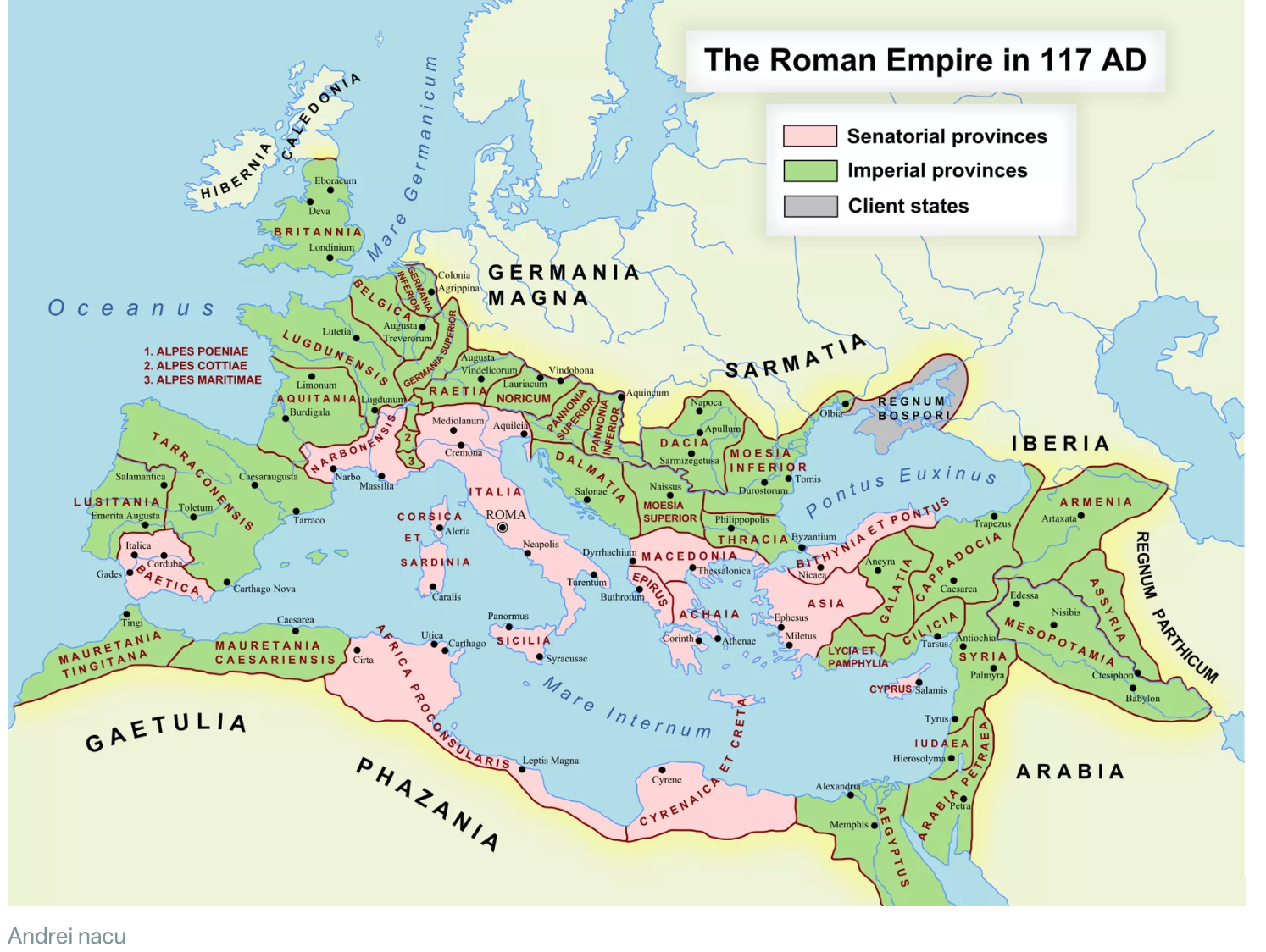
To discuss circus imagery, we have to refer to the Roman games and their place in the genesis of these tropes and images. The Roman games were not monolithic—they changed a lot over the centuries they were performed. Gladiatorial combat, according to historian Roland Auguet, began as a funeral tradition. Originally, a pair of slaves would be sacrificed on the tomb of a particularly valiant warrior.
However, as Roman sensibilities shifted away from human sacrifice it was decreed more humane to simply hand the slaves weapons and have them fight it out mano a mano. Watching men (and women) fight to the death was a popular spectacle, and snowballed into a full-blown Roman institution relatively quickly. Over the centuries, with cultural and linguistic drift, the term 'circus games' came to incorporate disparate terms and events under one big linguistic tent—the gladiatorial games encompassed mass battles and single combat, displays of acrobatics and skill, animal combats and displays of daring—some of which survived into our modern usage of the word ‘circus.’
With this institutionalization of gladiatorial combat came complexity, rules, and codification. Classes of gladiators—with different arms, armor and tactics—emerged from the former one-size-fits-all type combats of spear-on-spear or knife-on-knife. Take a look, from Head Injuries in Roman Gladiators:
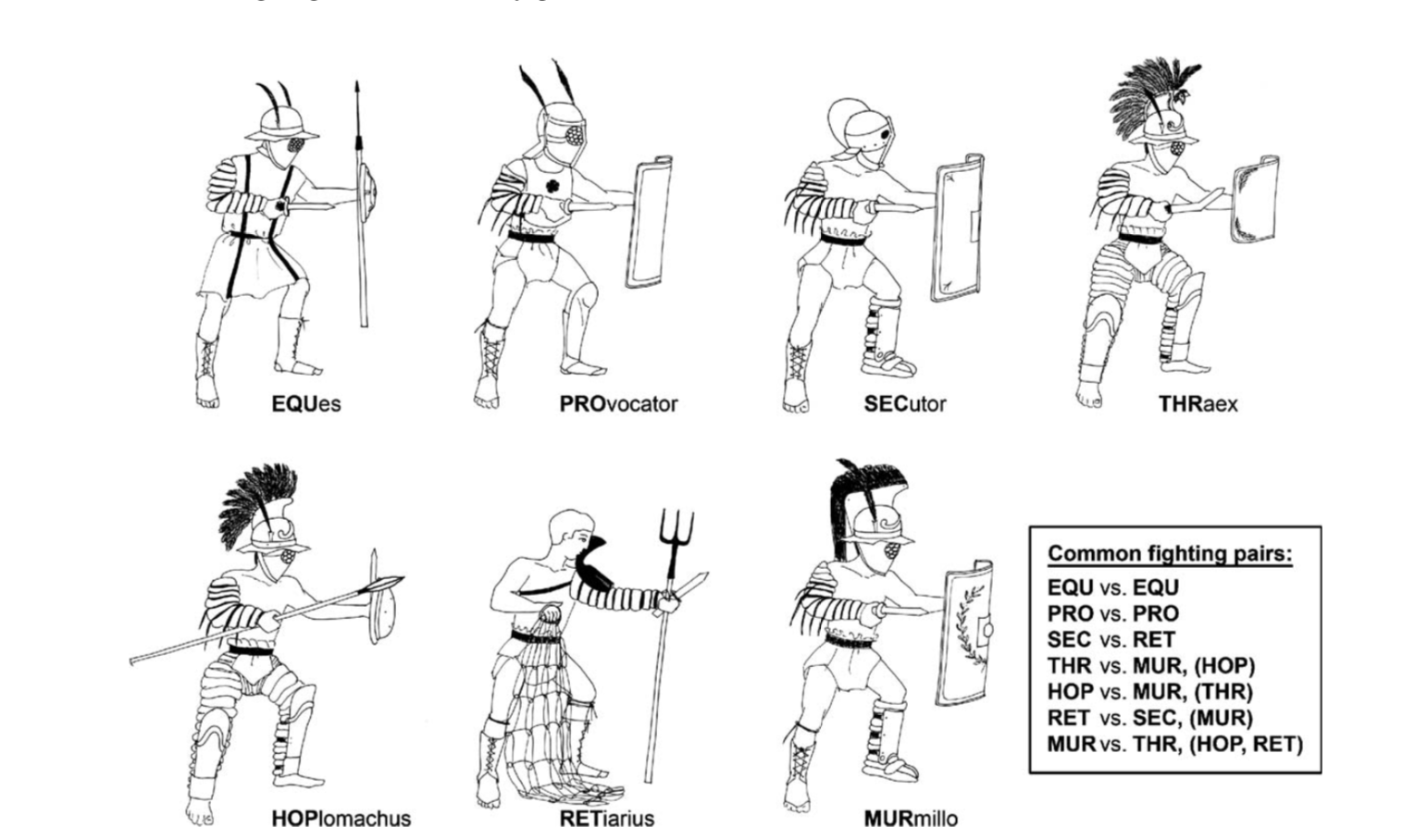
A list of gladiator types and the matchups between classes. Note the full helmets and emphasis on shields.
Roman citizens and spectators would become unhappy if it was just the same show and the same match-ups every time. You see, as a Roman citizen, you had a guaranteed right to attend the games for free. The crowd had a lot of power—in many ways, the key to public opinion lay in who sponsored the gladiatorial games, and thus could curry favor with the average Roman citizen.
The Romans quickly realized that they couldn't just throw two schlubs into a ring with knives and expect the crowd to be entertained at the bloodshed, although the Romans did do this as a way to have murderers and arsonists execute each other in public. That comprised a fraction of the Roman games, according to Auguet.
A trained gladiator was an expensive investment, as mentioned above, and the definition of 'gladiator' changed with the times and with historical context, moving away from being entirely slaves. To quote Kanz and Grossschmidt in their paper, Head-injuries of Roman Gladiators again:
“Gladiators were mainly recruited from among prisoners of war, slaves and condemned offenders. There have been two different judgments by the Roman jurisdiction that forced people to fight in the arena. The ad gladium contestants (those with swords) fought in the Arena without prior training, which by rule of thumb, meant certain death. The ad ludum participants (from the gladiator school) would receive appropriate training and education, and could prove their worth in the course of the fight and ultimately achieve freedom. In addition to those mentioned above, there were hobby (volunteer) gladiators, although the possibility to die was about 1:9, at least in the 1st century AD [1]: citizens, senators, noblemen, even emperors could all pursue training in gladiator schools.”
Here is a great example of the Romans varying the show: animals were a huge draw in the gladiatorial combats.
(Raise your hand if your first thought was that Surrak Dragonclaw would be right at home in the Roman games.)
Auguet describes the gladiators' fights against animals, done for variety and to entertain the audience in new ways:
"To tell the truth, fighting techniques [among gladiators] were very numerous. There were even men whose specialty was fighting with bare hands; they would stun a bear with a blow of the fist and seize it in their arms, or choke a lion by plunging an arm into its throat while gripping its tongue with the other hand."
However, animals were used both to fight armed and trained gladiators, and as methods of execution against unarmed or meagerly-armed criminals, or, more commonly, as the subject of in-arena-hunts.
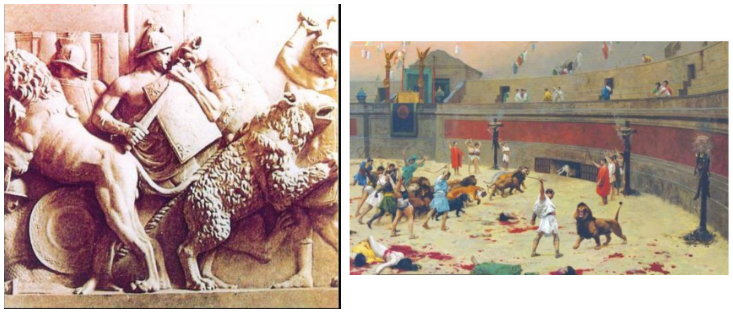
Gladiator arms and armor evolved, and a strict code of 'scoring' was instituted. Ludum participants, with the exception of the net-and-trident fighters, were protected by armor, helms, or shields to protect their limbs, leaving only the chest unprotected. This eliminated many tactics, such as winning through attrition (say, through cutting a hamstring and letting the opponent bleed out) or simply assassination (attacking the head exclusively). The only way to put down your opponent was to score a blow in the trunk, like in some schools of modern fencing.
Back to the Rakdos, who, of all the guilds of Ravnica, care about the aesthetics and acts of exuberance, all framed around violence and timing. Even their armor takes some visual cues from gladiatorial trends. Notice the manicae on the left arm on the card below.
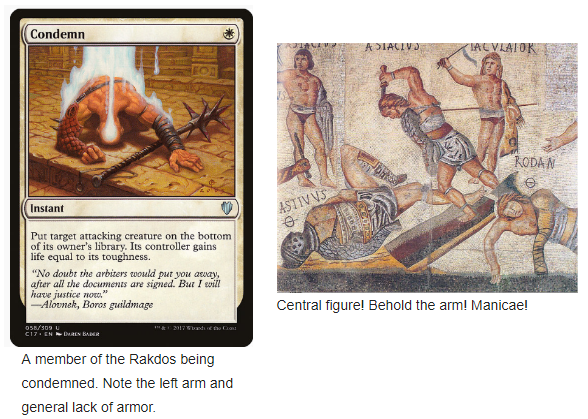
Manicae are a great example of the evolving armaments and adornments of gladiators. The manicae were meant to protect the arm not covered by the shield (heavy or otherwise) that many gladiators wore (with the exception of the retiarius, the net-and-trident fighter who eschewed most armor, even a helm, in favor of his weapons and was paired against heavily armored foes).
While the crowds could determine a gladiator's fate—choosing whether to spare a fallen gladiator, declaring a draw, or putting him to death—they were notoriously mercurial and individualistic.
Despite the variety of classes and matchups, if you were a Roman spectator born and raised on these matches, they would get repetitive quickly, forcing the sponsors of the games to get creative to entertain the crowds.
The following description wouldn't be out of place at a Rakdos festival, in the aftermath of the combats:
“His face was not altogether human. He had the nose-like beak of a bird of prey and held a long-handled mallet in his hand. He was the Etruscan Charon[god of the dead]…brandishing a red-hot caduceus which he applied to the flesh of the vanquished man to make sure that he was really dead and not merely unconscious or wounded. Proof established, Charon took possession of the dead by striking him with his mallet.”
Sound familiar? The Rakdos, after all, are quite fond of whips and singeing flesh on living, dead, or undead bodies (the difference seems to be academic to them). We can see evidence of this on the cards below:
According to the Guildmaster's Guide to Ravnica: "Making the powerful look ridiculous lies at the heart of the Rakdos performance philosophy...Making the ridiculous powerful is the flipside of [Rakdos philosophy]."
This element of satire has some overlap in principle with the gladiatorial games, where entire myths or famous battles would be scrupulously reenacted in mind-numbing, improbable detail. The Romans glorified the use of executive power and divine right of the upper classes by reenacting battles, even flooding the Colosseum to create naval battles.
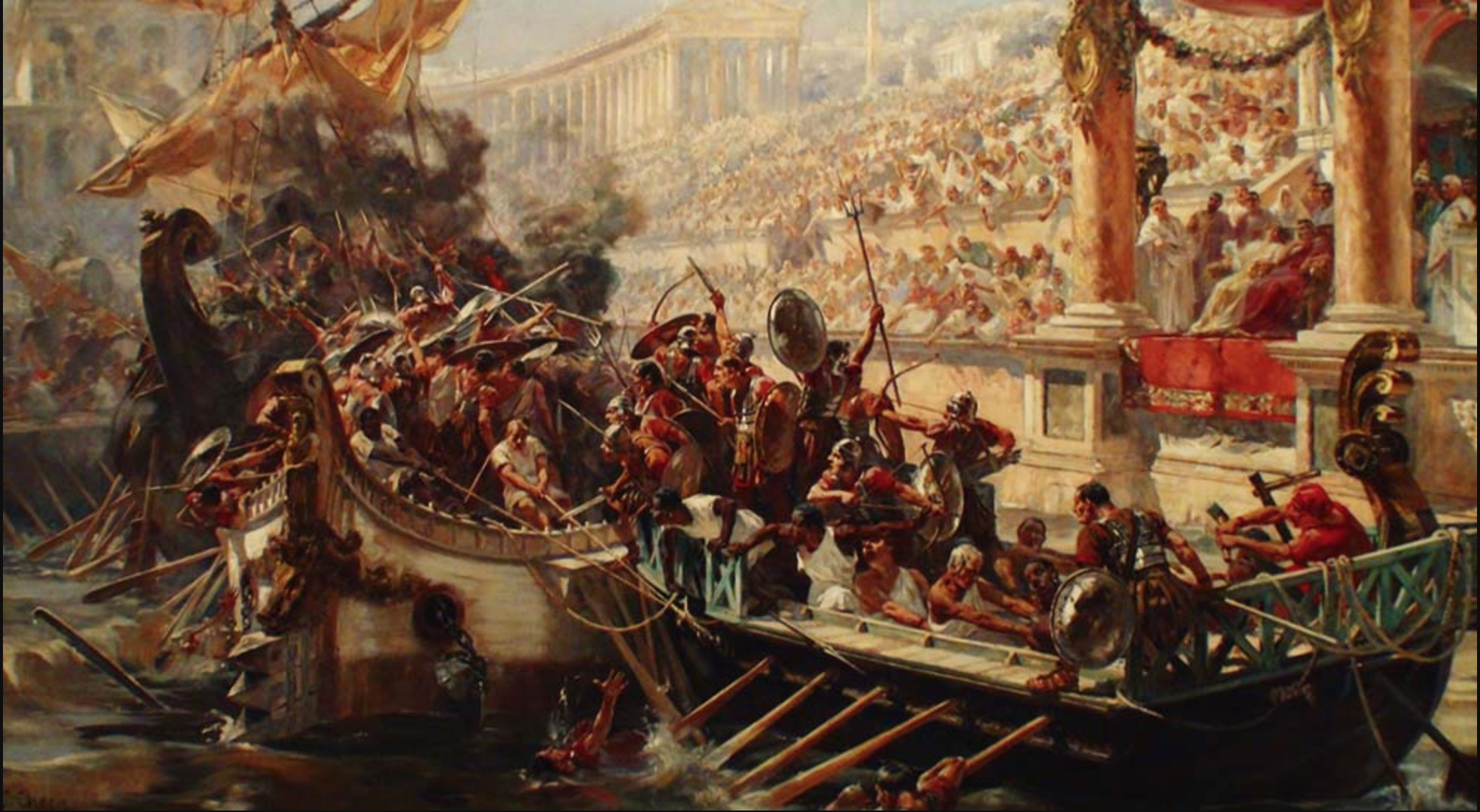
A later depiction of a Roman gladiatorial naval battle in the Colosseum.
In this, the Roman state and the Rakdos use fabulous production values to opposite ends. In the case of the Romans, these spectacles purpose was to reinforce the power of the Roman state. In the case of Rakdos, using the absurd instead of the mythical serves to skewer the presumptions of the other guilds and bring them back to earth.
Just look at the cards below and notice the Rakdos affinity for the bizarre: Zombie Fairies, amputee Goblins, or hijacking an Orzhov funeral to recruit one last performer.
The Rakdos also mirror the Roman games in that they seem to be equal opportunity employers of murder and mayhem. Their performers cross all species lines, and presumably class lines too. Of course, the Roman moral guardians, largely influenced by stoicism, railed against aspects of the gladiatorial games (famous humbug and philosopher Seneca being among them), saying it was unbecoming a proper Roman statesperson to be in the arena or to enjoy watching them overmuch like a member of the common rabble.

Seneca, the original Captain Fun Times.
Quoting Roman statesman Seneca in her article, Seneca's Gladiators, historian Heather Reid notes: "Nothing is as ruinous to the character as sitting away one’s time at a show – for it is then, through the medium of entertainment, that vices creep into one with more than usual ease. What do you take me to mean? That I go home more selfish, more self-seeking and more self-indulgent? Yes, and what is more, a person crueler and less humane through having been in contact with human beings. (Letter 7.2–3)."
Sounds a bit like something an Azorious hussar or senator would say about attending a Rakdos performance, doesn't it?
Historian Anna Miaczewska confirms the taboo appeal of gladiators across gender and class lines in Roman culture saying: “The humiliation of performing on the arena was not attached to women only, but also to high-ranked people of both sexes who, in Dio’s and Tacitus’ minds, stooped to the status of the most disgraced. As it has already been successfully argued by McCullough, “it was only possible to condemn women in the arena if the women were of the senatorial or equestrian orders,”but more importantly, the condemnation fell upon those only who could shame their order, regardless of whether they were women or men. The general criticism was therefore not so much of the munera per se, but of people of high social status.”
So it was an exciting thought to be a gladiator or play at being one. However, this sort of societal shaming did not occur for the volunteers or slaves who were of low social class, especially women. Miaczewska notes: “It also seems plausible that female slaves and low-born women undertook training similar in fashion to that of male gladiators, since their performances were probably lethal and specialized training was an essential part of their profession. Although there is a lack of evidence to support this theory, the marble relief from Halicarnassus 31 of two female gladiators is a proof that, at least on artistic media, the differences between men and women gladiators were non-existent.”
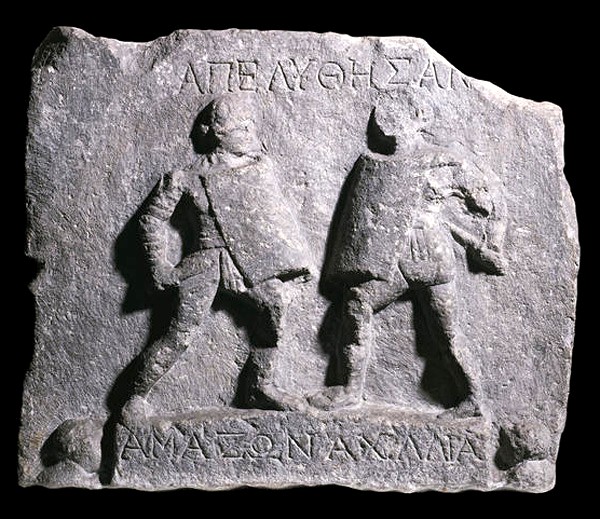
Two gladiatrices, Achilia and Amazonia, who fought to an even draw. Note the manicae covering their off-arms.
The Rakdos, who are open to anyone, have a view towards general egalitarianism of species and gender. The major powers, the secondary guild leaders in the Rakdos cult, other than the big Demon himself, are all women, each trained to combat and perform before cheering crowds:
The Rakdos performers do have a certain elan, if elan may here be defined as ‘maniacal zeal for performance.’
In all,The Rakdos circus acts and Roman gladiatorial games have more in common than one might credit. The Rakdos and Romans share significant overlap in their desire for novelty and freedom of expression, although with opposite intentions. Romans used the games as a political tool, a display of largesse and an outlet for the people's energy. The Rakdos are effectively the embodiment of the Roman gladiatorial spectacles and frolics, except that the walls of the Colosseum extend to an entire cityscape and they're in charge of bringing the frantic (and sometimes terminal) energy of the games to the people, whether they like it or not. Despite their differing agendas, each focuses on the spectacle of performance and terminal art.
To make a long story short, the next time you sit down at the EDH table and cast your Captive AudienceCaptive Audience, you've got a whole lot of gladiatorial history backing you up—and a whole performance ahead of you.
Works Cited:
Auguet, R. (1994). The Roman Games. London: Routledge.
Miączewska, Anna. (2012) Female Gladiators at the Roman Munera: a Fact or a Fantasy? Res Historica 34. https://www.academia.edu/37568905/Female_Gladiators_at_the_Roman_Munera_a_Fact_or_a_Fantasy
Reid, Heather (2010). Seneca's Gladiators Sport, Ethics and Philosophy https://www.tandfonline.com/doi/abs/10.1080/17511321.2010.486606
Kanz and Grossschmidt (2006) Head Injuries of Roman Gladiators Forensic Science International 160 https://www.academia.edu/7692174/Head_injuries_of_Roman_gladiators
Bell, Sinclair. (2016). Review: THE GAMES EMPERORS PLAYED. J. Toner The Day Commodus Killed a Rhino. Understanding the Roman Games.
http://journals.cambridge.org/abstract_S0009840X15002991
Crawford, Jeremy [Lead editor] (2018) A Planeswalker’s Guide to Ravnica Wizards of the Coast.
Charles Allison
I'm from just north of hell, I was schooled in a blossoming backwater, and currently am the worst living bureaucrat since Franz Kafka breathed his last, tremulous breath. I’ve been playing Magic: The Gathering since middle school, and Commander in particular since college, putting about a decade of experience brewing, scheming and fuming over historical travesties under my belt. I get dizzy walking in straight lines. I recently received my MFA from Arcadia University's creative writing program. My work has previously appeared in Podcastle, Stonecoast Review, Devilfish Review and Bride of Chaos.
Your opinions are welcome. We love hearing what you think about Magic! We ask that you are always respectful when commenting. Please keep in mind how your comments could be interpreted by others. Personal attacks on our writers or other commenters will not be tolerated. Your comments may be removed if your language could be interpreted as aggressive or disrespectful. You may also be banned from writing further comments.
